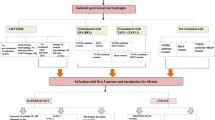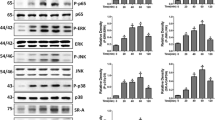Summary
Staphylococcus aureus (S. aureus) is an important human pathogen which can cause a chronic condition with a high relapse rate despite the aggressive antimicrobial treatment. Recent studies showed that intracellular pattern recognition receptors (including NOD) in response to bacteria or bacterial products play a proinflammatory role by activating nuclear transcription factor-κB (NF-κB). But how NOD2 mediates the proinflammatory response to S. aureus in mast cells (MCs) is unclear. So, in this study, we attempted to examine the role of NOD2 in inflammatory responses of MCs to S. aureus. P815 cells (a mouse mast cell line) were cultured. Real-time PCR was used to detect the NOD2 mRNA expression in P815 cells during S. aureus infection. The siRNA against NOD2 gene was synthesized and transfected into S. aureus-infected P815 cells. By using the methods of ELISA and flow cytometry, the effects of NOD2 gene silencing on cell phagocytosis, cytokine secretion, NF-κB activation and cell apoptosis of the S. aureus-infected P815 cells were examined. It was found that S. aureus infection could increase the expression of NOD2 mRNA in P815 cells. NOD2 gene interference in P815 cells reduced the number of S. aureus engulfed by P815 cells, the level of cytokines and the activation of NF-κB. In addition, S. aureus could induce the apoptosis of P815 cells, but NOD2 gene silencing did not affect the cell apoptosis rate. Our data suggested that NOD2 plays a key role in pathogen recognition, signal transduction, and NF-κB activation in the inflammatory responses of MCs infected by S. aureus.
Similar content being viewed by others
References
Lowy FD. Staphylococcus aureus infections. N Engl J Med, 1998,339(8):520–532
Aderem A, Ulevitch RJ. Toll-like receptors in the induction of the innate immune response. Nature, 2000,406(6797):782–787
Schnare M, Barton GM, Holt AC, et al. Toll-like receptors control activation of adaptive immune responses. Nat Immunol, 2001,2(10):947–950
Rosenkranz AR, Coxon A, Maurer M, et al. Impaired mast cell development and innate immunity in Mac-1 (CD11b/CD18, CR3)-deficient mice. J Immunol, 1998,161(12):6463–6467
Prodeus AP, Zhou X, Maurer M, et al. Impaired mast cell-dependent natural immunity in complement C3-deficient mice. Nature, 1997,390(6656):172–175
Talreja J, Kabir MH, Filla MB, et al. Histamine induces Toll-like receptor 2 and 4 expression in endothelial cells and enhances sensitivity to Gram-positive and Gram-negative bacterial cell wall components. Immunology, 2004,113(2):224–233
Akira S, Takeda K, Kaisho T. Toll-like receptors: critical proteins linking innate and acquired immunity. Nat Immunol, 2001,2(8):675–680
Dziarski R, Gupta D. Staphylococcus aureus peptidoglycan is a toll-like receptor 2 activator: a reevaluation. Infect Immun, 2005,73(8):5212–5216
Girardin SE, Boneca IG, Carneiro LA, et al. Nod1 detects a unique muropeptide from gram-negative bacterial peptidoglycan. Science, 2003,300(5625):1584–1587
Takeuchi O, Hoshino K, Kawai T, et al. Differential roles of TLR2 and TLR4 in recognition of gram-negative and gram-positive bacterial cell wall components. Immunity, 1999,11(4):443–451
Chamaillard M, Hashimoto M, Horie Y, et al. An essential role for NOD1 in host recognition of bacterial peptidoglycan containing diaminopimelic acid. Nat Immunol, 2003,4(7):702–707
Girardin SE, Boneca IG, Viala J, et al. Nod2 is a general sensor of peptidoglycan through muramyl dipeptide (MDP) detection. J Biol Chem, 2003,278(11):8869–8872
Girardin SE, Travassos LH, Herve M, et al. Peptidoglycan molecular requirements allowing detection by Nod1 and Nod2. J Biol Chem, 2003,278(43):41702–41708
Liu X, Chauhan VS, Marriott I. NOD2 contributes to the inflammatory responses of primary murine microglia and astrocytes to Staphylococcus aureus. Neurosci Lett, 2010,474(2):93–98
Kobayashi K, Inohara N, Hernandez LD, et al. RICK/Rip2/CARDIAK mediates signalling for receptors of the innate and adaptive immune systems. Nature, 2002,416(6877):194–199
Mccarthy JV, Ni J, Dixit VM. RIP2 is a novel NF-kappaB-activating and cell death-inducing kinase. J Biol Chem, 1998,273(27):16968–16975
Lin TJ, Gao Z, Arock M, et al. Internalization of FimH+ Escherichia coli by the human mast cell line (HMC-1 5C6) involves protein kinase C. J Leukoc Biol, 1999,66(6):1031–1038
Arock M, Ross E, Lai-Kuen R, et al. Phagocytic and tumor necrosis factor alpha response of human mast cells following exposure to gram-negative and gram-positive bacteria. Infect Immun, 1998,66(12):6030–6034
Wu L, Feng BS, He SH, et al. Bacterial peptidoglycan breaks down intestinal tolerance via mast cell activation: the role of TLR2 and NOD2. Immunol Cell Biol, 2007,85(7):538–545
Rocha-De-Souza CM, Berent-Maoz B, Mankuta D, et al. Human mast cell activation by Staphylococcus aureus: interleukin-8 and tumor necrosis factor alpha release and the role of Toll-like receptor 2 and CD48 molecules. Infect Immun, 2008,76(10):4489–4497
Hamill RJ, Vann JM, Proctor RA. Phagocytosis of Staphylococcus aureus by cultured bovine aortic endothelial cells: model for postadherence events in endovascular infections. Infect Immun, 1986,54(3):833–836
Shimada T, Park BG, Wolf AJ, et al. Staphylococcus aureus evades lysozyme-based peptidoglycan digestion that links phagocytosis, inflammasome activation, and IL-1beta secretion. Cell Host Microbe, 2010,7(1):38–49
Ellington JK, Harris M, Webb L, et al. Intracellular Staphylococcus aureus. A mechanism for the indolence of osteomyelitis. J Bone Joint Surg Br, 2003,85(6):918–921
Hess DJ, Henry-Stanley MJ, Erickson EA, et al. Intracellular survival of Staphylococcus aureus within cultured enterocytes. J Surg Res, 2003,114(1):42–49.
Palmqvist N, Patti JM, Tarkowski A, et al. Expression of staphylococcal clumping factor A impedes macrophage phagocytosis. Microbes Infect, 2004,6(2):188–195
Lin TJ, Garduno R, Boudreau RT, et al. Pseudomonas aeruginosa activates human mast cells to induce neutrophil transendothelial migration via mast cell-derived IL-1 alpha and beta. J Immunol, 2002,169(8):4522–4530
Mielcarek N, Hornquist EH, Johansson BR, et al. Interaction of Bordetella pertussis with mast cells, modulation of cytokine secretion by pertussis toxin. Cell Microbiol, 2001,3(3):181–188
Akira S, Uematsu S, Takeuchi O. Pathogen recognition and innate immunity. Cell, 2006,124(4):783–801
Plaut M, Pierce JH, Watson CJ, et al. Mast cell lines produce lymphokines in response to cross-linkage of Fc epsilon RI or to calcium ionophores. Nature, 1989,339(6219):64–67
Cole N, Bao S, Stapleton F, et al. Pseudomonas aeruginosa keratitis in IL-6-deficient mice. Int Arch Allergy Immunol, 2003,130(2):165–172
Shefler I, Salamon P, Reshef T, et al. T cell-induced mast cell activation: a role for microparticles released from activated T cells. J Immunol, 2010,185(7):4206–4212
Caron G, Delneste Y, Roelandts E, et al. Histamine induces CD86 expression and chemokine production by human immature dendritic cells. J Immunol, 2001,166(10):6000–6006
Caron G, Delneste Y, Roelandts E, et al. Histamine polarizes human dendritic cells into Th2 cell-promoting effector dendritic cells. J Immunol, 2001,167(7):3682–3686
Mazzoni A, Young HA, Spitzer JH, et al. Histamine regulates cytokine production in maturing dendritic cells, resulting in altered T cell polarization. J Clin Invest, 2001,108(12):1865–1873
Lien E, Sellati TJ, Yoshimura A, et al. Toll-like receptor 2 functions as a pattern recognition receptor for diverse bacterial products. J Biol Chem, 1999,274(47):33419–33425
Danforth JM, Strieter RM, Kunkel SL, et al. Macrophage inflammatory protein-1 alpha expression in vivo and in vitro: the role of lipoteichoic acid. Clin Immunol Immunopathol, 1995,74(1):77–83
Uehara A, Yang S, Fujimoto Y, et al. Muramyldipeptide and diaminopimelic acid-containing desmuramylpeptides in combination with chemically synthesized Toll-like receptor agonists synergistically induced production of interleukin-8 in a NOD2- and NOD1-dependent manner, respectively, in human monocytic cells in culture. Cell Microbiol, 2005,7(1):53–61
Kobayashi KS, Chamaillard M, Ogura Y, et al. Nod2-dependent regulation of innate and adaptive immunity in the intestinal tract. Science, 2005,307(5710):731–734
Shaw MH, Kamada N, Warner N, et al. The ever-expanding function of NOD2: autophagy, viral recognition, and T cell activation. Trends Immunol, 2011,32(2):73–79
Xu H, He Y, Yang X, et al. Anti-malarial agent artesunate inhibits TNF-alpha-induced production of proinflammatory cytokines via inhibition of NF-kappaB and PI3 kinase/Akt signal pathway in human rheumatoid arthritis fibroblast-like synoviocytes. Rheumatology, 2007,46(6):920–926
Hotchkiss RS, Dunne WM, Swanson PE, et al. Role of apoptosis in Pseudomonas aeruginosa pneumonia. Science, 2001,294(5548):1783
Jenkins CE, Swiatoniowski A, Power MR, et al. Pseudomonas aeruginosa-induced human mast cell apoptosis is associated with up-regulation of endogenous Bcl-xS and down-regulation of Bcl-xL. J Immunol, 2006,177(11): 8000–8007
da Silva Correia J, Miranda Y, Leonard N, et al. Regulation of Nod1-mediated signaling pathways. Cell Death Differ, 2007,14(4):830–839
Haslinger B, Strangfeld K, Peters G, et al. Staphylococcus aureus alpha-toxin induces apoptosis in peripheral blood mononuclear cells: role of endogenous tumour necrosis factor-alpha and the mitochondrial death pathway. Cell Microbiol, 2003,5(10):729–741
Menzies BE, Kourteva I. Staphylococcus aureus alpha-toxin induces apoptosis in endothelial cells. FEMS Immunol Med Microbiol, 2000,29(1):39–45
Author information
Authors and Affiliations
Corresponding author
Additional information
This project was supported by grants from the National Natural Science Foundation of China (No. 30873189) and the National 973 Project of China (MOST, 2007CB512900).
Rights and permissions
About this article
Cite this article
Xie, X., Wang, L., Gong, F. et al. Intracellular Staphylococcus aureus-induced NF-κB activation and proinflammatory responses of P815 cells are mediated by NOD2. J. Huazhong Univ. Sci. Technol. [Med. Sci.] 32, 317–323 (2012). https://doi.org/10.1007/s11596-012-0055-1
Received:
Published:
Issue Date:
DOI: https://doi.org/10.1007/s11596-012-0055-1




